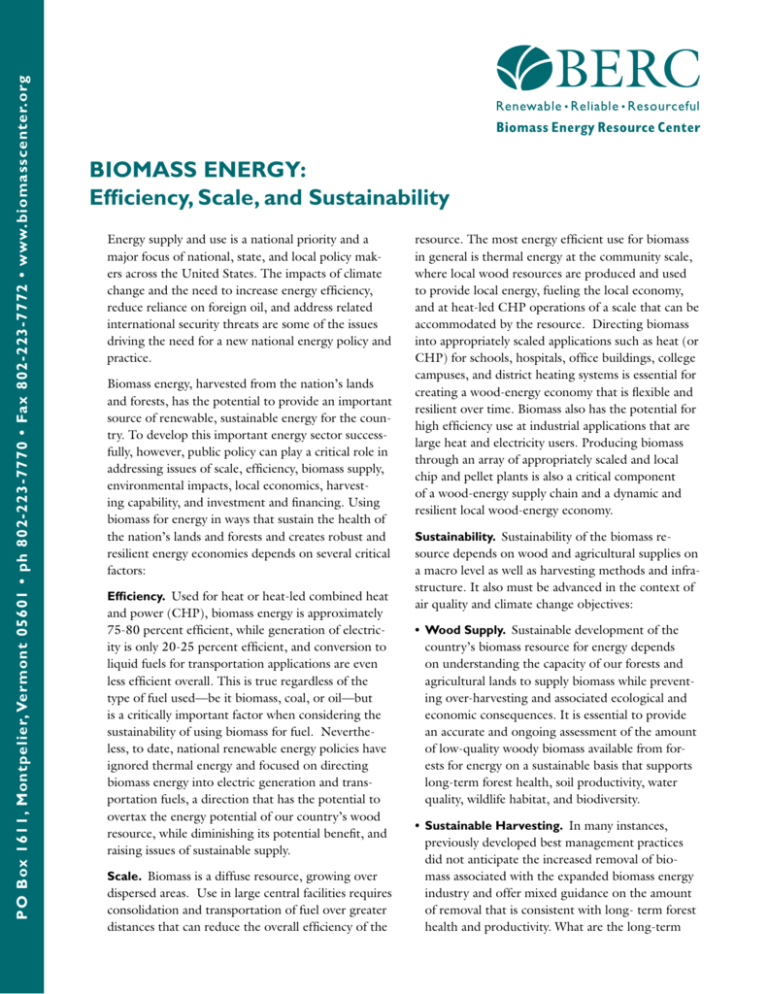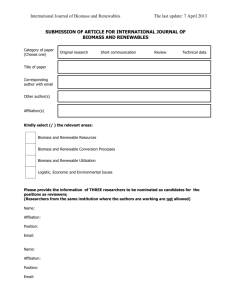
PO Box 1611, Montpelier, Vermont 05601 • ph 802-223-7770 • Fax 802-223-7772 • www.biomasscenter.org
BIOMASS ENERGY:
Efficiency, Scale, and Sustainability
Energy supply and use is a national priority and a
major focus of national, state, and local policy makers across the United States. The impacts of climate
change and the need to increase energy efficiency,
reduce reliance on foreign oil, and address related
international security threats are some of the issues
driving the need for a new national energy policy and
practice.
Biomass energy, harvested from the nation’s lands
and forests, has the potential to provide an important
source of renewable, sustainable energy for the country. To develop this important energy sector successfully, however, public policy can play a critical role in
addressing issues of scale, efficiency, biomass supply,
environmental impacts, local economics, harvesting capability, and investment and financing. Using
biomass for energy in ways that sustain the health of
the nation’s lands and forests and creates robust and
resilient energy economies depends on several critical
factors:
Efficiency. Used for heat or heat-led combined heat
and power (CHP), biomass energy is approximately
75-80 percent efficient, while generation of electricity is only 20-25 percent efficient, and conversion to
liquid fuels for transportation applications are even
less efficient overall. This is true regardless of the
type of fuel used—be it biomass, coal, or oil—but
is a critically important factor when considering the
sustainability of using biomass for fuel. Nevertheless, to date, national renewable energy policies have
ignored thermal energy and focused on directing
biomass energy into electric generation and transportation fuels, a direction that has the potential to
overtax the energy potential of our country’s wood
resource, while diminishing its potential benefit, and
raising issues of sustainable supply.
Scale. Biomass is a diffuse resource, growing over
dispersed areas. Use in large central facilities requires
consolidation and transportation of fuel over greater
distances that can reduce the overall efficiency of the
resource. The most energy efficient use for biomass
in general is thermal energy at the community scale,
where local wood resources are produced and used
to provide local energy, fueling the local economy,
and at heat-led CHP operations of a scale that can be
accommodated by the resource. Directing biomass
into appropriately scaled applications such as heat (or
CHP) for schools, hospitals, office buildings, college
campuses, and district heating systems is essential for
creating a wood-energy economy that is flexible and
resilient over time. Biomass also has the potential for
high efficiency use at industrial applications that are
large heat and electricity users. Producing biomass
through an array of appropriately scaled and local
chip and pellet plants is also a critical component
of a wood-energy supply chain and a dynamic and
resilient local wood-energy economy.
Sustainability. Sustainability of the biomass resource depends on wood and agricultural supplies on
a macro level as well as harvesting methods and infrastructure. It also must be advanced in the context of
air quality and climate change objectives:
• Wood Supply. Sustainable development of the
country’s biomass resource for energy depends
on understanding the capacity of our forests and
agricultural lands to supply biomass while preventing over-harvesting and associated ecological and
economic consequences. It is essential to provide
an accurate and ongoing assessment of the amount
of low-quality woody biomass available from forests for energy on a sustainable basis that supports
long-term forest health, soil productivity, water
quality, wildlife habitat, and biodiversity.
• Sustainable Harvesting. In many instances,
previously developed best management practices
did not anticipate the increased removal of biomass associated with the expanded biomass energy
industry and offer mixed guidance on the amount
of removal that is consistent with long- term forest
health and productivity. What are the long-term
nutrient cycle and soil productivity implications of
expanded biomass harvesting? What types of forest and
agricultural “biomass” will emerging markets prefer?
Will biomass energy markets compete for traditional
timber products or will they target previously unmerchantable forest biomass such as tops, branches,
and even stumps? A review and update of harvesting
standards is important to ensure sufficient post-harvest
retention of fine and course crop and woody debris,
standing and down dead wood for wildlife, biodiversity,
and site productivity. In addition to harvesting standards, biomass fuel procurement guidelines for public
and private facilities are important to ensure a sustainable supply chain.
• Harvesting Infrastructure and Capacity. While
there are concerns about the ecological sustainability
of biomass harvesting, there are also concerns about
the sustainability of the harvesting infrastructure and
workforce that will be needed to reliably supply wood
fuels to markets. Strong, reliable, and local markets for
low-grade wood such as wood fuel are essential to help
keep a reliable supply chain intact.
• Emissions. Energy derived from biomass energy must
minimize emissions and meet or surpass stringent public
health and air-quality standards. Biomass energy projects
should implement efficient combustion technologies
and best management practices for emission control
technologies, fuel quality, and operating conditions.
• Climate Change. Use of biomass for energy-efficient
and appropriately scaled applications has tremendous
potential to displace fossil fuels and, over the long
term, lower atmospheric CO2 emissions. Biomass
energy used in this manner is a “low-carbon fuel,”
and, integrated with the sustainable fuel supply, has the
potential to be a net carbon sequestering option, even
when considering the fossil fuels used in production
and transportation of wood fuel and agricultural production. The degree to which biomass energy systems
can reduce carbon emissions compared to fossil fuels
is directly related to establishment and management
of harvesting regimes, forest types, fuel transport, and
efficiency. National carbon sequestration and reduction
policies such as carbon cap and trade regulations and
voluntary carbon standards will also have an impact on
forest management and agricultural decisions regarding carbon storage, forest adaptation, production of
biomass for energy, and harvesting of traditional wood
products. Policies must be put in place that optimize
carbon storage, adaptation potential, biomass used for
energy, and the harvest of traditional products.
Public Policy Recommendations for
Efficient Biomass Energy
1. Develop a National Thermal Energy Policy
that includes the following elements:
-A Renewable Thermal Standard (comparable
to the existing Renewable Fuels Standard and
proposed Renewable Electricity Standard)
-National and state carbon policies and greenhouse gas emissions programs that support the
most efficient thermal uses of biomass
-Federal and state incentives, grants, and loans
to advance the utilization of high efficiency
biomass thermal systems
-Renewable Portfolio Standards that include
thermal energy, provision of renewable energy
credits for thermal applications and that promote efficient use of biomass
2. Fund and conduct accurate and ongoing assessments of sustainable biomass energy supply
3. Support biomass harvesting standards, sustainable
forest management, and procurement guidelines
to ensure a sustainable supply chain for timber and
other biomass harvesting activities
4. Support harvesting and management infrastructure—including policies that encourage and
promote the long-term economic viability of
the supply chain to ensure forestry and logging
capacity—and sound land stewardship and management practices necessary to ensure low-grade
wood resource availability for sustained biomass
energy use over the long term
5. Establish consistent federal and state air emission
standards and regulations for biomass energy to
minimize emissions and meet stringent public
health and air-quality standards
6. To support the ability of biomass energy to help
reduce climate change, support forest conservation efforts, provide offset credits and other
incentives for increased carbon sequestration and
storage, and address forest adaptation due to
changing climate
Adopted by the BERC board of directors on August 14, 2009.
© Copyright 2009 Biomass Energy Resource Center. All rights reserved.










